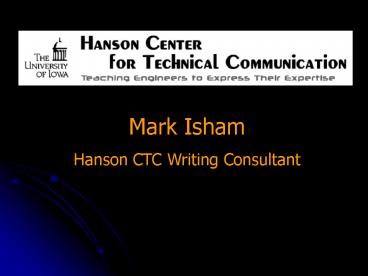Sample Introduction - PowerPoint PPT Presentation
1 / 16
Title:
Sample Introduction
Description:
Explain your procedure so that some one can duplicate it. Answer audience questions. ... Using APA: sample of. in-text and Reference List citations. In-text: ... – PowerPoint PPT presentation
Number of Views:362
Avg rating:3.0/5.0
Title: Sample Introduction
1
Mark Isham Hanson CTC Writing Consultant
2
Fall 07 Grading Support for Materials Science
- Hanson Center professional writing staff will
grade the following assignments - Lab Report 2 (due September 17 - 21)
- Project Proposal (due October 30)
- Final Project Report (due December 19)
3
Grading Overview
- We will grade for logic, clarity of expression,
and proper formatting. - Of the 50 points you receive for each assignment
we grade, 20 points will be based on your
writing. - For a closer look at our grading criteria, see
the writing evaluation sheets online by clicking
the Materials Science link on the Hanson
Centers (CTC) home page.
4
Signs of ExcellenceWhat We Look for as Graders
- A clear, concise, non-technical Abstract so that
a top executive can review and act on the
report. - Introduction and Background and Discussion and
Conclusion sections that provide detail but
remain general enough so that immediate
supervisors can understand main points even if
they are not subject- matter experts. - Professionals in your field will understand
Experimental Methods, Results, and Appendices
sections.
5
The Lab Report(2 due September 17 - 21)
- The lab report measures your individual ability
to document your procedures and explain the
significance of the lab experiment to others. - Write lab reports that can be understood by a
broad audience. - Present your procedures and findings in a
coherent manner that allows experts in your field
to easily duplicate the experiment. - Organize your lab report in the following manner
Abstract, Introduction and Background,
Experimental Methods, Results, Discussion,
Conclusion, References, Appendices. - See (http//www.engineering.uiowa.edu/ctc/) for
specific instructions.
6
The Lab ReportAvoid Plagiarism
- Although you may do the work of the labs with
others, you must write a report on your own. - Copying the written work of others or any
collaboration with others on writing the report
may mean that you receive no credit for the lab.
In addition, you may be charged with plagiarism
and your teacher or the University may take
further action.
7
The Project Proposal (due October 30)
- Your team will propose a study, which involves
testing a material for a specific application. - Address clients needs and offer solutions to
their problems. Your team must present the
material in a coherent manner so that clients can
see answers to their questions about the
soundness of your project and your ability to
complete it. - The proposal also offers a roadmap to the final
project. To that end, organize your proposals by
sections in the following manner Cover Sheet,
Project Summary, Research Plan, Specific Aims,
Background and Significance, Research Design and
Methods, References. - See (http//www.engineering.uiowa.edu/ctc/) for
specific instructions.
8
The Final Project Report (due December 13)
- The final report documents the experiment your
team conducted based on your project proposal. - To that end, organize your teams final report in
the same manner as a lab report Abstract,
Introduction and Background, Experimental
Methods, Results, Discussion, Conclusion,
References, Appendices. - See (http//www.engineering.uiowa.edu/ctc/) for
specific instructions.
9
Remember
- Write to specific audiences.
- Organize coherently.
- Write unified paragraphs and use strong subjects
and verbs in sentences. - Cite your sources and include a reference page.
- Tell what you did, how you did it, and why you
did it. Your audience wants both clarity and
analysis.
10
You Must Convince Your Audience That You
- Define a problem.
- Offer a practical solution.
- Explain your procedure so that some one can
duplicate it. - Answer audience questions.
11
A Source for Sources
- The Hanson CTC uses the American Psychological
Association (APA) documentation style for all the
written assignments we evaluate. No style is
"better" than the other be it MLA or APA, the
key is to stay consistent and give credit where
credit is due.
12
Using APA sample of in-text and Reference List
citations
- In-text
- Such a bridge is said to be in equilibrium,
meaning that the net result of the forces and
moments acting on the structure are equal to zero
(Hibbeler, 2004). - Reference list
- Hibbeler, R.C. (2004). Engineering Mechanics
Statics. Upper Saddle River, NJ Prentice Hall.
13
How to avoid plagiarism?
- Paraphrasing means that you have taken someone
else's ideas, concepts or language and put them
in your own words. Since writers often build on
other people's ideas or borrow from other
people's work to support their own scholarship,
this practice is perfectly acceptable. - HOWEVER, you must give credit where credit is
due. If you use someone else's material and
rewrite it in your own words, you must provide a
citation after that paraphrased information every
time you paraphrase.
14
How to avoid plagiarism?
- If you have any questions about documenting or
citing material, ask questions, you can check
with the CTC. They have individuals who can help
you with documentation and citation questions. - A final thought. Better to cite too often than
not often enough. The road to academic hell is
paved with plagiarized papers.
15
Questions?
- Visit the Hanson Center for Technical
Communication - You can find the assignments, evaluation sheets,
discussions of plagiarism, and other useful stuff
on the Centers web site at http//www.engineering
.uiowa.edu/ctc. - Hours 130 430 p.m. Monday-Friday, Sunday
700-900 p.m. - Location 2224 SC (in the Student Commons area)
- Scheduling Appointment sign-up sheet posted on
window outside door of 2224 SC
16
Thank You































